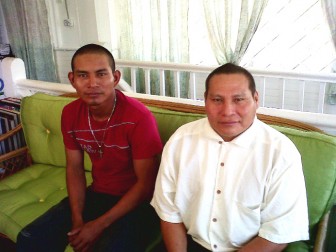Deep in the rainforests of southern Guyana, Masa-kenari, long known as a bastion for conservation, is in a renewed push for economic development.
But this must be in line with its conservation ethic, the toshao of the village, Paul Chekema says. ‘Green’ development, he believes, could be the answer as the community’s population grows and more children pass to and graduate from secondary school.
The remote Wai-Wai community, which has a population of 252 persons, is already formally protecting its land as Guyana’s first Community Owned Conservation Area.

He said that the village is interested in being a part of a National Protected Areas System (NPAS). In July, a US$8.5 million ($1.7B) Trust to manage Guyana’s protected areas, funded by the German Government and Conservation International was launched. The fund will provide long-term financing for the management of Guyana’s intact protected areas system and will support efforts by the government, along with local communities, to manage the country’s protected areas. The fund was established in part to recognize the outstanding contribution of the protected areas initiative for Guyana, the region and the world.
It was said at the time that the protected areas are the Kanuku Mountains, Shell Beach, Kaieteur National Park and Iwokrama Rainforest Reserve, and the community-owned Conservation Area at Konashen, which together account for almost 9% of Guyana.
Chekema said that his people need to advance economically and at a recent village meeting, they approved a renewed push to seek ways in which this can be accomplished and they focused specifically on the NPAS. He said that few villagers, about 17 persons, have jobs and the others farm and hunt. Sometimes there are temporary jobs but he pointed out that for the first time, the community has had four students graduating from secondary school in Region Nine and four more are in school. “When they finish school, they just go there (in the village), no jobs,” he said. “I wonder what will I do, because they will want little jobs, especially since they finish CXC.”
He said that he will approach the Ministry of Amerindian Affairs to see if the graduates can be trained and equipped with skills that they can put to use in the village.
The toshao said that the village had hopes in tourism but last year only three tourists visited. He said that villagers also make craft for sale and sometimes he brings some to the regional capital, Lethem to sell during major events and also to Georgetown. The villagers also harvest Brazil nuts but there are no markets, he said. “I don’t want my people to go out far away from the village and never come back because they don’t have jobs,” the village chief said.
Some have begun to do this. When there was a gold strike in Para-Bara last year, some villagers moved to the area but returned, he said. Some of the young men have also moved further afield.
One of them is Enoch Mawasha, 25. He said that he left the community in May and went to the work at a mine in the Cuyuni because there were no jobs in Masakenari. The father of three, who left his wife and children in the community, said that he is going back home to farm but plans to return to the goldfields early next year to earn money.
Chekema said that he believes that the NPAS will be see more jobs available for villagers. He said that he had gotten a letter informing him that $1.5 billion was available for those part of the NPAS but how exactly the process will work, has not been made clear. He said that joining the NPAS is what the village is aiming for. “We want to join NPAS, so we want to know how it will work,” he said. “We want advancement.”
The village leader stressed that while they want to see some changes in the economic circumstances of the community, they also want to ensure that their culture is preserved.




